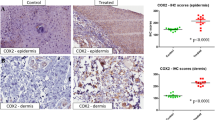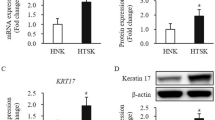Abstract
Extracorporeal shock wave therapy (ESWT) has been extensively studied for its multiple biological properties, and although it is widely applied in esthetical procedures, little is known about its effects on the epidermis and dermis. In this study, a histological and immunohistochemical study of the effects of ESWT was performed on rat skin. Forty-five female rats were treated with one or two sessions of ESWT and sacrificed on days 1, 7, 14, and 21 after treatment. The samples were histologically processed and then morphometric analyses were performed to assess the epidermis, dermis, and subcutaneous fat tissue thickness. Immunohistochemical reactions were also performed against the antibodies: basic fibroblastic growth factor (FGF2), its receptor (FGFR1), and α-smooth muscle actin. Slides were scanned and digitally assessed, to determine the microvessel density (MVD) and digital scoring of the immunohistochemical staining. The results showed that ESWT produced a significantly higher collagen content, MVD, and epidermis and dermis thickness than the control, non-treated group. Both in epidermis and dermis, FGF2 was overexpressed in the ESWT-treated groups, whereas FGFR1 was increased only in the group treated with two ESWT sessions at 21-days post-treatment. The ESWT-treated groups have also shown diminished thickness of subcutaneous fat tissue. In conclusion, ESWT induces neocollagenesis and neoangiogenesis, and upregulates the FGF2 expression, particularly in the groups treated with two sessions. Furthermore, it was demonstrated that overexpression of FGF2 on skins treated with ESWT seems to be a key role on its mechanism of action.



Similar content being viewed by others
References
Nobile V, Michelotti A, Cestone E (2016) A home-based eyebrows lifting effect using a novel device that emits electrostatic pulses containing RF energy, resulting in high frequency, low level transdermal microcurrent pulsations: double blind, randomized clinical study of efficacy and safety. J Cosmet Laser Ther 18:234–238. https://doi.org/10.3109/14764172.2016.1156704
Widgerow AD, Fabi SG, Palestine RF et al (2016) Extracellular matrix modulation: optimizing skin care and rejuvenation procedures. J Drugs Dermatol 15:s63–s71
Fitzpatrick RE, Rostan EF (2003) Reversal of photodamage with topical growth factors: a pilot study. J Cosmet Laser Ther 5:25–34
Sclafani AP, McCormick SA (2012) Induction of dermal collagenesis, angiogenesis, and adipogenesis in human skin by injection of platelet-rich fibrin matrix. Arch Facial Plast Surg 14:132–136. https://doi.org/10.1001/archfacial.2011.784
Meyer PF, de Oliveira P, Silva FKBA et al (2017) Radiofrequency treatment induces fibroblast growth factor 2 expression and subsequently promotes neocollagenesis and neoangiogenesis in the skin tissue. Lasers Med Sci 32:1727–1736. https://doi.org/10.1007/s10103-017-2238-2
Bikfalvi A, Klein S, Pintucci G, Rifkin DB (1997) Biological roles of fibroblast growth factor-2. Endocr Rev 18:26–45. https://doi.org/10.1210/edrv.18.1.0292
Nugent MA, Iozzo RV (2000) Fibroblast growth factor-2. Int J Biochem Cell Biol 32:115–120. https://doi.org/10.1016/S1357-2725(99)00123-5
Cross MJ, Claesson-Welsh L (2001) FGF and VEGF function in angiogenesis: signalling pathways, biological responses and therapeutic inhibition. Trends Pharmacol Sci 22:201–207. https://doi.org/10.1016/S0165-6147(00)01676-X
Dantas Filho AM, Aguiar JL, Rocha LR, Azevedo IM, Ramalho E, Medeiros AC (2007) Effects of the basic fibroblast growth factor and its anti-factor in the healing and collagen maturation of infected skin wound. Acta Cir Bras 22:64–71. https://doi.org/10.1590/S0102-86502007000700013
Makino T, Jinnin M, Muchemwa FC et al (2009) Basic fibroblast growth factor stimulates the proliferation of human dermal fibroblasts via the ERK1/2 and JNK pathways. Br J Dermatol 162:717–723. https://doi.org/10.1111/j.1365-2133.2009.09581.x
Schlessinger J, Plotnikov AN, Ibrahimi OA et al (2000) Crystal structure of a ternary FGF-FGFR-heparin complex reveals a dual role for heparin in FGFR binding and dimerization. Mol Cell 6:743–750. https://doi.org/10.1016/S1097-2765(00)00073-3
Yan D, Chen D, Cool SM et al (2011) Fibroblast growth factor receptor 1 is principally responsible for fibroblast growth factor 2-induced catabolic activities in human articular chondrocytes. Arthritis Res Ther 13:R130. https://doi.org/10.1186/ar3441
Mittermayr R, Antonic V, Hartinger J et al (2012) Extracorporeal shock wave therapy (ESWT) for wound healing: technology, mechanisms, and clinical efficacy. Wound Repair Regen 20:456–465. https://doi.org/10.1111/j.1524-475X.2012.00796.x
Kuo Y-R, Wu W-S, Hsieh Y-L et al (2007) Extracorporeal shock wave enhanced extended skin flap tissue survival via increase of topical blood perfusion and associated with suppression of tissue pro-inflammation. J Surg Res 143:385–392. https://doi.org/10.1016/j.jss.2006.12.552
Schaden W, Thiele R, Kölpl C et al (2007) Shock wave therapy for acute and chronic soft tissue wounds: a feasibility study. J Surg Res 143:1–12. https://doi.org/10.1016/j.jss.2007.01.009
Birgin E, Gebhardt C, Hetjens S et al (2018) Extracorporal shock wave therapy enhances receptor for advanced glycated end-product-dependent flap survival and angiogenesis. Ann Plast Surg. https://doi.org/10.1097/SAP.0000000000001279
Goh C (2009) The need for evidence-based aesthetic dermatology practice. J Cutan Aesthet Surg 2:65–71. https://doi.org/10.4103/0974-2077.58518
Soares CD, Borges CF, Sena-Filho M et al (2017) Prognostic significance of cyclooxygenase 2 and phosphorylated Akt1 overexpression in primary nonmetastatic and metastatic cutaneous melanomas. Melanoma Res 27:448–456. https://doi.org/10.1097/CMR.0000000000000368
Knobloch K, Kraemer R (2015) Extracorporeal shock wave therapy (ESWT) for the treatment of cellulite – a current metaanalysis. Int J Surg 24:210–217. https://doi.org/10.1016/J.IJSU.2015.07.644
Zhang X, Yan X, Wang C et al (2014) The dose–effect relationship in extracorporeal shock wave therapy: the optimal parameter for extracorporeal shock wave therapy. J Surg Res 186:484–492. https://doi.org/10.1016/j.jss.2013.08.013
Rosso F, Bonasia DE, Marmotti A et al (2015) Mechanical stimulation (pulsed electromagnetic fields “PEMF” and extracorporeal shock wave therapy “ESWT”) and tendon regeneration: a possible alternative. Front Aging Neurosci 7:211. https://doi.org/10.3389/fnagi.2015.00211
Vetrano M, d’Alessandro F, Torrisi MR et al (2011) Extracorporeal shock wave therapy promotes cell proliferation and collagen synthesis of primary cultured human tenocytes. Knee Surg Sports Traumatol Arthrosc 19:2159–2168. https://doi.org/10.1007/s00167-011-1534-9
Frairia R, Berta L (2011) Biological effects of extracorporeal shock waves on fibroblasts. a review. Muscles Ligaments Tendons J 1:138–147
Kuo Y-R, Wang C-T, Wang F-S et al (2009) Extracorporeal shock wave treatment modulates skin fibroblast recruitment and leukocyte infiltration for enhancing extended skin-flap survival. Wound Repair Regen 17:80–87. https://doi.org/10.1111/j.1524-475X.2008.00444.x
Wang C-J (2003) An overview of shock wave therapy in musculoskeletal disorders. Chang Gung Med J 26:220–232
Meirer R, Brunner A, Deibl M et al (2007) Shock wave therapy reduces necrotic flap zones and induces VEGF expression in animal epigastric skin flap model. J Reconstr Microsurg 23:231–236. https://doi.org/10.1055/s-2007-981506
Serizawa F, Ito K, Matsubara M et al (2011) Extracorporeal shock wave therapy induces therapeutic lymphangiogenesis in a rat model of secondary lymphoedema. Eur J Vasc Endovasc Surg 42:254–260. https://doi.org/10.1016/j.ejvs.2011.02.029
Hausdorf J, Sievers B, Schmitt-Sody M et al (2011) Stimulation of bone growth factor synthesis in human osteoblasts and fibroblasts after extracorporeal shock wave application. Arch Orthop Trauma Surg 131:303–309. https://doi.org/10.1007/s00402-010-1166-4
Adatto MA, Adatto-Neilson R, Novak P (2011) Body shaping with acoustic wave therapy AWT(®)/EPAT(®): randomized, controlled study on 14 subjects. J Cosmet Laser Ther 13:291–296. https://doi.org/10.3109/14764172.2011.630089
Knobloch K, Joest B, Vogt PM (2010) Cellulite and extracorporeal shockwave therapy (CelluShock-2009)--a randomized trial. BMC Womens Health 10:29. https://doi.org/10.1186/1472-6874-10-29
Hruza GJ, Dover JS (1996) Laser skin resurfacing. Arch Dermatol 132(4):451–455
Rostan EF (2005) Laser treatment of photodamaged skin. Facial Plast Surg 21(2):99–109
Tao L, Wu J, Qian H (2015) Intense pulsed light, near infrared pulsed light, and fractional laser combination therapy for skin rejuvenation in Asian subjects: a prospective multi-center study in China. Lasers Med Sci 30(7):1977–1983. https://doi.org/10.1007/s10103-015-1792-8
Funding
This study was funded by the Brazilian National Council of Scientific and Technological Development (CNPq) research fellowship (registered under numbers 145722/2013-9, 101367/2014-7, and 117277/2014-2 to C.D.S.) and by FAPESP (São Paulo Research Foundation) for the Ph.D. fellowship to C.D.S. (#2015/25905-1).
Author information
Authors and Affiliations
Corresponding author
Ethics declarations
This experimental protocol followed the guidelines of the Animal Experimentation Code of Ethics and Brazilian College of Animal Experimentation and was duly approved by the Ethics Committee of Potiguar University, Laureate International Universities (protocol number 002/2017).
Conflict of interest
The authors declare that they have no conflicts of interest.
Informed consent
Not applicable. This article does not contain any studies with human participants.
Electronic supplementary material
Supplementary Figure 1
A: The device utilized for the experiments. B: Image demonstrating the use of the device in one subject. (PNG 4691 kb)
(AVI 11631 kb)
Rights and permissions
About this article
Cite this article
de Lima Morais, T.M., Meyer, P.F., de Vasconcellos, L.S. et al. Effects of the extracorporeal shock wave therapy on the skin: an experimental study. Lasers Med Sci 34, 389–396 (2019). https://doi.org/10.1007/s10103-018-2612-8
Received:
Accepted:
Published:
Issue Date:
DOI: https://doi.org/10.1007/s10103-018-2612-8




